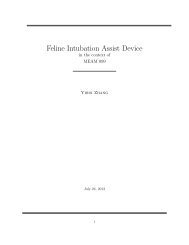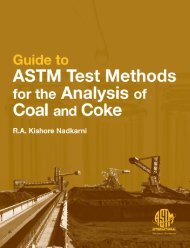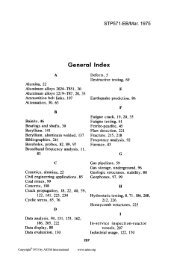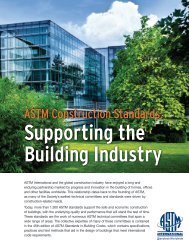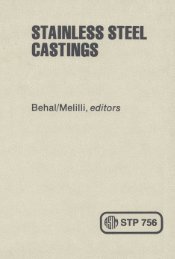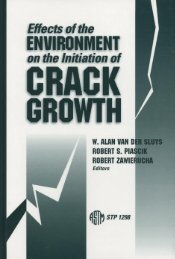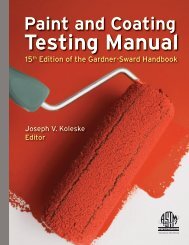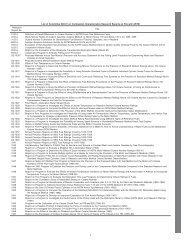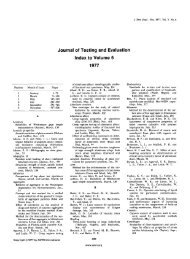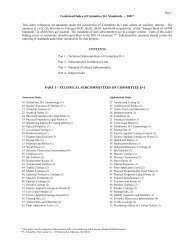D01:Global Paint Standards - ASTM International
D01:Global Paint Standards - ASTM International
D01:Global Paint Standards - ASTM International
Create successful ePaper yourself
Turn your PDF publications into a flip-book with our unique Google optimized e-Paper software.
group develops specifications for traditional<br />
artist oils and watercolors, among<br />
other standards.<br />
The subcommittee also has the<br />
long-term goal, according to Skalka, of<br />
increasing the international use of the<br />
lightfastness rating system for colorants<br />
in art materials. The system, covered<br />
in D4303, Standard Test Methods for<br />
Lightfastness of Colorants Used in<br />
Artists’ Materials, addresses how to<br />
perform accelerated exposures. The<br />
information guides producers and users<br />
about suitable colorants because, according<br />
to the standard, “The retention<br />
of chromatic properties by a colorant<br />
over a long period of years is essential<br />
in a work of art.”<br />
The <strong>ASTM</strong> AnD ISO PAInT<br />
MOU<br />
In today’s more global marketplace, the<br />
paint industry is attempting to harmonize<br />
standards on the same topic from<br />
different organizations, with the goal of<br />
making the standards more technically<br />
equivalent. Members of Committee<br />
<strong>D01</strong> members and its counterpart in<br />
the <strong>International</strong> Organization for<br />
Standardization (ISO), Technical Committee<br />
35 on <strong>Paint</strong>s and Varnishes,<br />
have participated in the work of both<br />
groups in developing and reviewing<br />
similar standards.<br />
In 2001, to further cooperation<br />
between the two groups and to eliminate<br />
the creation of separate ISO and<br />
<strong>ASTM</strong> standards for the same property,<br />
ISO TC 35 on <strong>Paint</strong>s and Varnishes<br />
and <strong>D01</strong> signed a memorandum of<br />
understanding. Similar, but not necessarily<br />
identical, standards, according to<br />
the MOU, foster marketplace confusion<br />
and contradictions between the<br />
standards, increase testing and human<br />
resource costs, and require constant<br />
“catch-up” to align requirements between<br />
the two standards.<br />
Through the MOU, <strong>D01</strong> and ISO<br />
TC 35 agree not to develop a standard<br />
when one already exists that fulfills<br />
market needs, and they are working<br />
to eliminate duplicate standards. In<br />
addition, the agreement notes that the<br />
groups would determine which standard<br />
would remain if two exist.<br />
“Where we’ve come in the last<br />
several years with the MOU is encouraging,”<br />
Peters notes, “but we’ve got a lot<br />
more work to do.”<br />
MOre <strong>D01</strong> STAnDArDS WITh<br />
InTernATIOnAl USe<br />
Fletcher notes examples of other <strong>ASTM</strong><br />
standards with broad international<br />
use such as those for fineness of grind<br />
(D1210 and D1316), Ford and Zahn<br />
viscosity cups (D1200 and D4212), and<br />
spiral bar coaters (D4147). 1<br />
Peters cites D4400, Test Method<br />
for Sag Resistance of <strong>Paint</strong>s Using a<br />
Multinotch Applicator, which describes a<br />
simple and rapid procedure to demonstrate<br />
sag resistance through numerical<br />
values for observations. He says that the<br />
applicator is unique and that the <strong>ASTM</strong><br />
test helps paint designers balance sag<br />
resistance — the paint’s ability to stay on<br />
the wall — with another needed attribute<br />
called leveling, which is the paint’s ability<br />
to fill in minor imperfections.<br />
And, D3359, Test Methods for Measuring<br />
Adhesion by Tape Test, known as<br />
the crosshatch test, gives both laboratory<br />
and field testing options to assess<br />
the adhesion of coating films to metallic<br />
substrates by applying and removing<br />
pressure sensitive tape over cuts in the<br />
film. The test works for coatings in<br />
many different industries: automotive,<br />
marine, construction, printing, electronics<br />
and more. In fact, D3359 is <strong>D01</strong>’s<br />
best-selling standard.<br />
These are just a sampling; <strong>D01</strong>’s<br />
standards make their way around the<br />
world through global commerce and<br />
just plain usefulness.<br />
As Peters says, “One way or the<br />
other, <strong>ASTM</strong> <strong>D01</strong> methods influence a<br />
great deal of testing around the world.”<br />
FOr MOre InFOrMATIOn<br />
All those interested are welcome to<br />
participate in the work of <strong>ASTM</strong> Committee<br />
<strong>D01</strong>. To learn more, go to www.<br />
astm.org/COMMIT/<strong>D01</strong>, or contact Jeffrey<br />
Adkins, <strong>ASTM</strong> staff manager (610-<br />
832-9738; Email: jadkins@astm.org).<br />
ReFeReNCe<br />
1. D1210, test method for Fineness of Dispersion<br />
of pigment-Vehicle systems by Hegman-type<br />
Gage; D1316, test method for Fineness of Grind<br />
of printing Inks by the NpIrI Grindometer;<br />
D1200, test method for Viscosity by Ford Viscosity<br />
cup; D4212, test method for Viscosity by<br />
Dip-type Viscosity cups; and D4147, practice for<br />
applying coil coatings Using the wire-wound<br />
Drawdown bar.<br />
<strong>Paint</strong><br />
w w w . a s t m . o r g s e p t e m b e r / O c t O b e r 2 0 1 1 o a s t m S T A N D A R D I Z A T I O N N e w s 29



